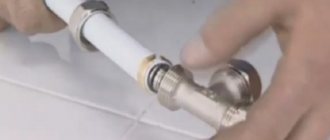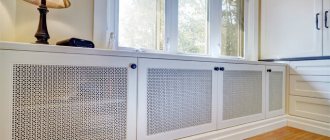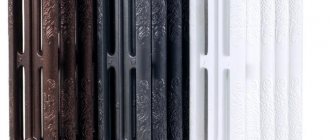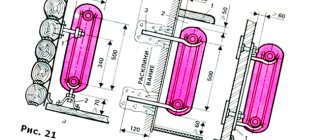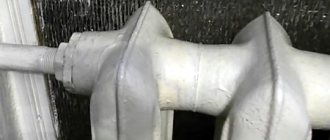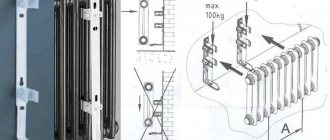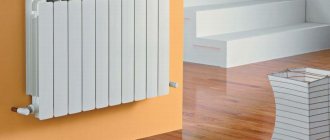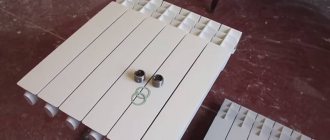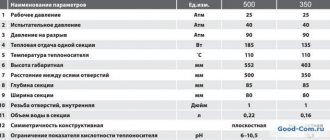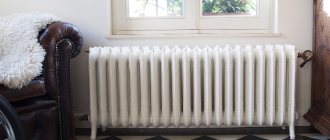It's hard to find a more boring item in the house than radiators. It doesn’t matter at all what style the interior of the room is designed in if the view is spoiled by the awkward structures placed in each room of the home. They can be covered with decorative elements, but if you have imagination, you can really come up with an interesting design for an integral attribute of the apartment. If you have a stable financial situation, you can purchase elegant radiators from popular brands that will be designed in any suitable interior style (retro, art deco, hi-tech, modern, Provence). If your soul asks for something unusual, you can create radiator decor with your own hands.
Making a reading place above the radiator by the window
To disguise an unsightly heating radiator, a reading bench is made. It will be a stylish detail in the bedroom. The best option for decorating the battery is to install a special neat grille directly under the window. Thus, the heating element will not be visible at all: instead there will be a neat decorative grille.
The advantage of this design solution is both aesthetic and practical: thanks to the battery under the window sill, you don’t have to worry about a cold seat in winter. The radiator will warm up the place to relax, so you can comfortably spend time with a book in your hands. The grille is selected to match the overall color scheme of the interior. White color will look best.
Where does the heat go?
Heating devices in buildings are installed under the windows.
The goal is to warm the air inside and create a thermal curtain that prevents the penetration of cold from the street.
Heat spreads from a heated object to a cold one.
The wall temperature is lower than that of the radiator.
In the cold season, the surface behind it heats up to 35-40 °C.
Instead of heating the air inside a warehouse or office, some of the energy is used to heat the external walls.
Decorative screen
The decor of a radiator involves the use of various screens. It is important not to block the flow of warm air and use materials that do not lose their basic qualities due to constant exposure to high temperatures. The structures can be suspended or supported on the floor covering. An effective design solution is to use a screen-box in the form of a cabinet with doors. It can become a kind of table. A decorative screen is needed to make the room look aesthetically pleasing.
Most of the available radiators are not aesthetically pleasing and have some problems due to functional features. A radiator is a product that has a complex design and is necessary to ensure high heat exchange rates between the battery case and the environment. This interior element has two significant disadvantages. The first is sharp corners, which can hurt you, tear clothes, curtains, expensive curtains. The second is an inconvenient design that is constantly clogged with dust. Because of this, it is difficult to clean the radiator, and with an impressive accumulation of cobwebs, it looks ugly. There are two criteria according to which they can be divided into the following: by type of construction and the material from which they are made.
If you pay attention to the principles of division into categories, you get the following:
By design, screens are:
| Flat | Such decorative elements are more often used for batteries in a niche, when they are located in the area under the window sill and framed by a wall. It should immediately be noted that ventilation holes must be installed in the window sill itself. This is necessary for air circulation from the radiator. Otherwise, the feasibility of mounting the battery will be minimal. At the moment, this type of screen is considered the simplest and most accessible. |
| Mounted | Used for radiators that are installed on the plane of the wall. The screen is mounted on the radiator itself and acts as a so-called housing. A significant disadvantage of this design is that the radiators must also be designed for the weight of the screen. When choosing such a design, you need to pay attention to the fact that the plane of the screen must have holes. This allows warm air to circulate better. |
| Attached | The more advanced, complex screen design actually frames the battery body. The cost of such a design is high, due to the complexity of execution and expensive appearance. It has several significant advantages, one of which is the independence of installation relative to radiators, when there is no need to install special hooks. |
Based on the material, screens can be made of plastic, metal, MDF, wood, and glass:
- plastic - affordable designs that are not environmentally friendly. During operation, the material will constantly release harmful compounds. After a certain period of time has passed, the structure will lose its original shape. In addition to other characteristics, the screen will change color to a more faded, unattractive one. White will eventually turn yellow. This is facilitated by heating of the entire structure. The only positive aspects regarding the purchase of this decorative element are accessibility and resistance to moisture. You can safely dry wet items of clothing on this design after washing.
- metal - the advantages of this material include lightness, rigidity, strength, environmental friendliness, and durability. Screens are suitable for people with average incomes. They are made of special stainless steel. If desired, you can give it any desired color. You can dry wet clothes on them. Among the significant disadvantages: if the protective coating is damaged, the structure will quickly begin to rust and lose its former attractive appearance.
- MDF - you can use it to create any interesting shapes that will become an interesting addition to the interior. The material is cheap. Contains glue. When heated, the toxic substance will evaporate and enter the air in the room. MDF is afraid of moisture, so it can become deformed over time.
- wood - screens have an impressive design, but they are short-lived. This applies to cheap designs. Cons: wood cannot come into contact with a humid environment.
- glass - the designs look impressive. Due to the fact that they are hardened, the likelihood of cutting yourself is reduced. Among the disadvantages of such screens is fragility.
When deciding to create a battery screen with your own hands, you should not forget that plastic is not the best option. It is a poor conductor of heat and tends to change its original shape when exposed to high temperatures.
Why do you need foil?
The coefficient of reflection of thermal radiation of polished aluminum is higher than that of other metals.
This means that maximum heat will return inside the room.
You should not use screens with a double-sided metal backing.
The layer of foil on the side of the cold wall does not carry a functional load - it simply has nothing to reflect.
Unscrupulous sellers in construction markets deceive customers by talking about new metallized coatings with fantastic characteristics.
These are fairy tales.
Any polished metal refracts heat rays, but the reflection coefficient is negligible and does not affect thermal efficiency.
The cost per square meter of a thermal reflective screen with aluminum foil is more expensive than with a metallized film.
The difference is small - 5-10 rubles.
Pros of a heat reflective screen
DIY painting ideas
Updating the radiator decor is carried out in compliance with the interior style. Designs painted in the same color as the walls look impressive. With proper design, you can divert attention from the shortcomings of the interior. As for painting ideas, multi-colored sections are used, giving the radiator a piano look, and applying a modular pattern. The main thing is that the type of coloring fits perfectly into the overall concept of the room. To paint a radiator “to look like a piano,” you need to think through everything so that the resulting pattern resembles the keys of a popular musical instrument. You will need two colors of paint: black, white.
Coloring, art painting
The technique is considered one of the most attractive from the point of view of maintaining the amount of heat transfer. In addition, it does not require installation work to install the box. The disadvantage is that painting the radiator is not safe for children. The sharp metal corners of the radiator will remain uncovered.
Artistic painting Source stat01.com
The range of varieties of heat-resistant paints allows you to choose the color that best suits your interior and quickly paint over the white surface of the radiator. The result will not be long in coming, even if it is not possible to completely replicate the background of the walls. A little lighter or darker – it doesn’t matter. The main thing is that this is no longer a white “spot” against the background of, for example, a dark wall.
It is not necessary to give the batteries the color of the wall surfaces. With their help you can create a unique decorative element. It is enough to draw a burning fireplace, a shelf with some object or something else on them. The drawing can be different, from a banal image of a piece of furniture to an original landscape or still life.
Decoupage - step-by-step master class
It will help give the radiator a certain chic. Decoupage involves selecting drawings and then gluing them onto the surface to be restored. The resulting image is fixed with varnish. Today in stores you can buy special multi-layer napkins with a pattern. Step-by-step master class:
- The battery is cleaned using detergents. Areas with peeling paint are cleaned with sandpaper. The radiator is coated with paint.
- You need to start applying the drawing after the coloring composition has completely dried.
- Unroll the prepared napkins and cut out the required fragments. Excess layers of paper are completely removed. The image is coated with PVA glue and applied to the radiator sections. Gently press the napkin onto the battery. Air bubbles are removed. After the layer of paper has dried, you can complete the missing elements with your own hands.
- The completely dry image is covered with two layers of varnish.
Decorative lattice - master class
To make a screen for a niche radiator design, you need to take several steps:
- Making a template in the form of a design you like from waste plywood.
- Going through the template with a jigsaw.
- It needs to be processed with a milling cutter. It is important to achieve ideal transitions between the details of the ornament.
- To close the niche with the battery you need to prepare several templates. Depending on the width of the niche, you should choose your number of fragments.
- They need to be sanded and coated with special enamel. It is important to make special holes for fastening.
- After the enamel has completely dried, the parts are sanded and painted with the required shade of paint.
- The parts are secured using fasteners.
False fireplace - master class
This option is suitable for masking a radiator located in the center of the room. Making a fireplace is as follows:
- You need to prepare a furniture panel, 1 cm thick plywood, bars of the required size, and a wooden layout.
- You should create an approximate layout of the fireplace that covers the radiator. It should be a special square with a window in the center. The design of the structure depends on the preferences of the performer.
- The box is fixed on the wall. Shelves on the fireplace, pre-made from furniture board, are screwed on. The entire structure can be decorated with special polyurethane skirting boards.
- We go through the joints with self-tapping screws with putty. We sand off the excess and paint the surface of the fireplace with acrylic paint.
You can install a lamp in the firebox that will serve as an imitation of fire. If desired, you can install a garden trellis on top of the niche. The battery should be covered with imitation stone.
School energy passport
In accordance with Federal Law No. 261-FZ “On Energy Saving...”, budgetary institutions must:
- reduce energy consumption.
- organize accounting of energy resource consumption.
- organize an energy audit.
Until December 31, 2012, budgetary organizations are required to conduct an energy audit, with a subsequent frequency of 5 years. Based on the energy survey data, an energy passport and an energy saving program are drawn up with a list of measures aimed at increasing the energy efficiency of energy consumption. At the moment, all budgetary institutions of the Russian Federation must be provided with meters for water, gas, heat, and electricity. Since 2010, budgetary organizations must ensure an annual reduction in energy consumption by at least 3%.
In 2012, based on the results of a mandatory energy audit, an Energy Passport for the school was compiled, which contains information about the establishment and consumption of thermal energy, and the final report provided recommendations for the implementation of energy saving measures.
Plasterboard finishing
Using drywall you can easily hide an unsightly battery. You must have minimal skills in repair and construction work. The method allows you to completely close the radiator and niche. To disguise the battery, you need to make a plasterboard box attached to metal profiles. It is attached to the wall, all holes from the screwdriver are carefully puttied and sanded. The structure is covered with a primer, and then with a layer of paint. It is necessary to leave windows for ventilation, thanks to which warm air will circulate in the room.
Instructions for DIY production and installation
Any of the materials considered can be used to make screens yourself. It is necessary to objectively assess your skills, take into account the availability of tools and the availability of components for sale.
The work is carried out according to a single algorithm:
- Choose a design based on a photo or sample.
- Measurements are taken of the radiator and installation location: height, width, depth of the niche.
- Make a sketch and, if possible, an accurate drawing of the screen.
- The instrument is being prepared.
- Purchase materials, including consumables (paint, fasteners).
- A frame is made and sheathed with the selected material.
- Finishing is carried out.
- Attach using the chosen method to the wall or floor.
You can inspect the model you like at a construction supermarket and then start making it yourself.
Glass or mirror screen
You will need:
- drill or screwdriver;
- hammer drill for drilling a wall for fasteners;
- glass drill bit.
- a glass cutter and a diamond block, if you are cutting the glass yourself.
Glass or mirror can be ordered according to the required sizes in stores or workshops, and the edges will be processed there. The price of glass (at least 6 mm) with a cut ranges from 1,000 to 2,000 rubles per square meter. Holders will cost from 1,000 rubles. per set.
Additionally, holder brackets can be purchased.
Holder brackets.
They can be of different designs, but must hold the panel in a vertical position.
Self-production algorithm:
- The glass is cut to the required size, taking into account gaps for air circulation.
- Treat the edge with a diamond stone or fine sandpaper.
- Using a crown of the required diameter, drill a hole for the holder. The drill is set to minimum speed, and as you work, the drilling site is watered with water.
- Make markings to install the holders on the wall or floor.
- Drill a hole and attach the brackets.
- Install the glass on the holders.
Before drilling, try to perform the operation on an unnecessary piece of glass.
Another no-drilling option involves using prefabricated brackets and nickel-plated posts. All materials can be purchased at any construction supermarket.
The surface can be covered with a tinted film of the same color or with a pattern.
Protective box made of MDF, HDF
Prepared:
- drill (screwdriver), hammer drill or impact drill for concrete walls;
- jigsaw;
- a hacksaw with fine teeth complete with a miter box;
- construction corner, ruler or tape measure;
- a set of screwdrivers of the required configuration;
Buy:
| perforated MDF or HDF panel of the required size - from 600 RUR/m2 | |
| MDF panels of the required width for the top side and side walls from 200 rub. for a 3-meter piece, the upper part can be made from a solid piece of board | |
| planed block 20x30 mm from 30 rubles/linear. meter | |
| self-tapping screws 35x25 mm from 30 kopecks/piece. | |
| 12 steel corners for assembling the frame from 5 rubles/piece. | |
| wooden or MDF corner for finishing from 50 rub./l.m. | |
| furniture hangers for attaching the frame to the wall from 2 rubles/piece. | |
| hidden nails or glue for installing decorative corners |
MDF panels can be replaced with laminate.
Sequence of work:
- Conduct final measurements of the opening.
- Make a drawing.
- The HDF panel is cut and cut to the required dimensions, it is advisable to maintain the symmetry of the pattern.
- Mark and cut off the frame bars.
- Using steel corners, assemble the frame.
- Hangers are attached for further installation.
- The top and sides are covered with MDF panels.
- Secure the perforated panel using self-tapping screws screwed into the corners.
- The box is finished with a decorative corner.
- Mark holes in the wall, drill and screw in screws on which the box will be hung.
- Place the screen in place.
If necessary, the entire structure can be removed in a few seconds.
Some of the purchased MDF screens have sufficient thickness and strength so as not to make a frame; then the panels are connected using furniture corners. You can watch the video for more details:
Steel screens are made using similar schemes.
Forged gratings
To work, in addition to the hammer drill, you will need an angle grinder, an arc welding machine, a protective mask and electrodes.
Blanks for the grating are purchased at a construction supermarket. The price depends on the part configuration and size.
To obtain the grid:
- The frame is welded from a steel angle or profile pipe.
- Monograms and racks are welded.
- Clean the weld areas with a grinder.
- Paint the finished product.
- Attach the grille to the wall or floor.
Important! Welding cannot be carried out indoors, since the gases released are toxic, and the smell does not disappear from the room for several days. Observe fire safety measures: protect flammable objects and the floor with screens, prepare a supply of water in case of fire.
Pipe decor
If you paint walls, radiators, pipes in the same color, then visually they will merge into one plane. You can use one ornament for decoration, which will allow the latter to get lost in the background. For painting, you can use special stencils (vinyl), which can obtain the desired shape. There are a large number of finishing options: it all depends on the design style. If the interior is made in an oriental style, you can use a bamboo trunk to hide the radiator sections. You need to vertically saw the bamboo trunk, open it, and insert a pipe there. You can wrap the pipes with a beautiful rope - you get an interesting composition.
Disadvantages of the material
Energy-saving film is not a source of heat and does not affect the heating of the room. Retains heat produced by central heating sources. The material maintains the existing air temperature.
Through a window covered with athermal protection, heat from the street does not penetrate
Disadvantages of the material:
- The protection does not allow UV radiation to pass through and is not recommended for use in rooms with indoor plants. Not suitable for tinting glass in greenhouses and greenhouses in the local area. Plants need ultraviolet light to grow. If there are plants in a room with energy-saving coating, you can use phytolamps. However, you can forget about saving energy - for normal plant growth and compensation for the lack of sunlight, lighting must work at least 12 hours a day.
- The effectiveness of the film coating depends on proper gluing. It is better not to cover large areas of glazing - for example, panoramic windows or portals - by yourself.
- The coating prevents the penetration of natural solar heat from outside into the room; in spring and autumn the apartment will be uncomfortable - damp, cold. Mobile heating devices must be turned on.
- Ability to reflect radio signals. Radio waves from the outside going to the indoor antenna or mobile phone are reflected by the coating. There may be interruptions in cellular communications.
- If the room has window systems with two or three-chamber double-glazed windows, it is not necessary to use film.
Application in the interior
Below are the most interesting ideas:
- Living room. You can decorate the radiator using a decorative false fireplace or a special plasterboard box. It all depends on your imagination and the style direction of the interior.
- Kitchen. You can cover the heating element with a special screen, which is consistent with the overall interior concept. If desired, you can simply paint it in a contrasting color.
- Bedroom. A decorative grille, screen or false fireplace will fit here. You can paint the batteries with an interesting design or use the decoupage technique.
- Children's room. An interesting option would be to design it using decoupage technique. The child really likes to look at the beautiful modular pictures.
Criteria for choosing types of heating radiators for an apartment
- Operating pressure.
This indicator can be found in the product passport, which you should definitely pay attention to. It should not exceed the pressure in the heating system (in any case, no more than 1.5 times)
If we take into account the operating features of Russian utility organizations, pressure drops (test and working) become one of the most important causes of failure of modern heating devices.
For example, the average pressure level in five-story old residential buildings is usually up to 8 atmospheres. While in modern multi-storey buildings, a coolant with an operating pressure of up to 15 atmospheres is most often used.
- Resistant to water hammer.
This determines the service life of the product and the operating efficiency of all types of heating radiators. It is impossible to protect yourself from water hammer in an apartment with centralized heating. Therefore, it is necessary to choose heating devices with high resistance to water hammer.
- Number of sections.
Some heating devices can be expanded during use. And if you do not have the opportunity to immediately determine the required size of the radiator, or you are not sure of the efficiency of a particular model, you should give preference to these types of heating radiators.
- Radiator power.
This factor is certainly key. Not all types of heating devices are capable of maintaining an optimal microclimate in homes if the temperature drops to -40 °C in winter
Then you should pay attention to the maximum coolant temperature. Some models from foreign manufacturers are rated up to +90 °C
But in those regions where severe winters are expected, it is necessary to select products with a maximum temperature of up to +130 ° C.
- Coolant composition.
Almost no Russian utility organization is distinguished by the high quality of the coolant, which wears out the walls of the radiator. When choosing a heating device, you should take this factor into account and choose a radiator with thick walls.
- Design and design of products.
If you are choosing a battery for an apartment with modern decoration, then you probably do not want to install an old-style volumetric structure.
- Product service life.
This criterion is determined by the working conditions and technical features of the utility service. Replacing batteries in an apartment is not the cheapest thing, so when choosing a device, give preference to types of heating radiators that will last you at least 20–25 years.
- Easy to install.
This is important if you plan to install radiators yourself. A heavy cast iron structure is not suitable for these purposes, while lightweight panel batteries can be installed by anyone.
- Manufacturer.
As a rule, the fame and impeccable reputation of the manufacturing company is important. The modern market offers products from numerous European and domestic manufacturers. Consumers often give preference to German and Italian companies, as well as Spanish, Austrian and Polish brands.
Radiators from AQUALINK are quite popular. These heating devices are suitable for installation in both autonomous and centralized heating systems. Heating devices made of aluminum and bimetallic types of radiators are designed specifically for use in heating systems in the Russian Federation. Due to the high heat transfer of the sections, the AQUALINK device is suitable for use in low-temperature heating systems, and due to the low inertia, fast and effective thermoregulation in rooms is carried out.
Our
supplies aluminum and bimetallic radiators to Russia. The main areas of our activity are presented:
- large wholesale trade in engineering plumbing equipment;
- organizing the delivery of our goods throughout the Russian Federation and the CIS;
- production of sanitary products.
Aluminum and bimetallic types of AQUALINK heating radiators are presented in a rich assortment with a different number of sections - 4, 6, 8, 10, 12. All radiator models are painted with snow-white epoxy enamel. You can also choose components for heating devices, which are represented by kits for connecting batteries, mounting brackets, adapters, plugs, manual air vents, control and shut-off valves. All products are insured and have passed the voluntary certification procedure in the GOST R system.
